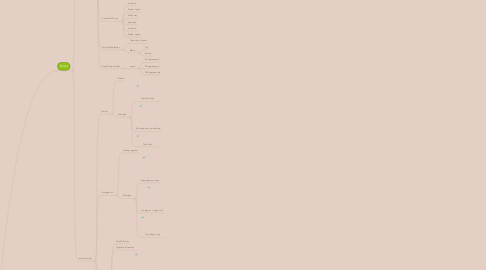
1. Examples
1.1. Bike Helmet
1.2. Igloo
2. Dome
3. Form
3.1. The way the structure is built.
3.1.1. Solid
3.1.1.1. Large Mass
3.1.1.2. Support Loads
3.1.1.3. Solid Materials
3.1.1.4. Last long time
3.1.1.5. Examples
3.1.1.5.1. Concrete Dam
3.1.1.5.2. Wooden Telephone Pole
3.1.1.5.3. Marble Statues
3.1.1.5.4. Solid Brick
3.1.1.5.5. Apple
3.1.2. Frame
3.1.2.1. Can Be Strong
3.1.2.2. Work Together
3.1.2.3. Resist Forces
3.1.2.4. Lighter
3.1.2.5. Examples
3.1.2.5.1. Goalie's Net
3.1.2.5.2. Spiderweb
3.1.2.5.3. Skeleton
3.1.3. Frame Chairs
3.1.4. Shell
3.1.4.1. Hollow
3.1.4.2. A lot Strong
3.1.4.3. Higid
3.1.4.4. Very Light
3.1.5. Combination
3.1.5.1. Most Structures Are Combination
3.1.5.2. Solid
3.1.5.3. Shell
3.1.5.4. Frame
3.1.5.5. Solid Foundation
3.1.5.6. Support
3.1.5.7. More Strength
3.1.5.8. Examples
3.1.5.8.1. Humans
3.1.5.8.2. House
4. Egg
5. Loads
5.1. Static Loads
5.1.1. Dead Loads
5.1.1.1. The weight of structure itself
5.1.1.1.1. Examples
5.1.2. Live Loads
5.1.2.1. The weight of people, or goods in structure
5.1.2.1.1. Examples
5.2. Dynamic Loads
5.2.1. Forces that change rapidly
5.2.1.1. Examples
5.2.1.1.1. Rain hitting the building
5.2.1.1.2. Tornado hitting the building
6. Function
6.1. How does it useful
6.1.1. A house
6.1.1.1. Gave you a place to live
6.1.1.2. Gave you a comfortable tempeture
6.1.1.3. Can relax in your home
6.1.2. Couch
6.1.2.1. Can sit
6.1.2.2. Can relax
7. Forces
7.1. External Forces
7.1.1. Live load
7.1.1.1. Can move on a structure
7.1.1.1.1. An animal
7.1.1.1.2. Legs
7.1.1.1.3. A person
7.1.1.1.4. A hand
7.1.2. Dynamic load
7.1.2.1. The thing that can change the structure
7.1.2.1.1. Wind
7.1.2.1.2. Rain
7.1.2.1.3. Snow
7.1.2.1.4. Even a person
7.1.3. Dead load
7.1.3.1. The structure itself
7.1.3.1.1. A building
7.1.3.1.2. A house wall
7.1.3.1.3. A house
7.1.3.1.4. A shoe
7.1.3.1.5. Ground
7.1.4. Magnitude Of Force
7.1.4.1. Measure Of Strength
7.1.4.2. Examples
7.1.4.2.1. Hammer Nail On Board
7.1.5. Direction Of Force
7.1.5.1. Direction
7.1.5.2. Where it goes
7.1.5.3. Which way
7.1.5.4. Examples
7.1.5.5. Direction
7.1.5.6. Where it goes
7.1.6. Point Of Application
7.1.6.1. The point of impact
7.1.6.2. Where
7.1.6.2.1. Top
7.1.6.2.2. Bottom
7.1.7. Plane Of Application
7.1.7.1. Angle
7.1.7.1.1. 45 degree angle
7.1.7.1.2. 90 degree angle
7.1.7.1.3. 180 degree angle
7.2. Internal Forces
7.2.1. Tension
7.2.1.1. Stretch
7.2.1.2. Examples
7.2.1.2.1. Stretch Springs
7.2.1.2.2. Shooting an arrow with bow
7.2.1.2.3. Tug A War
7.2.2. Compression
7.2.2.1. Pushing together
7.2.2.2. Examples
7.2.2.2.1. Squeezing a sponge
7.2.2.2.2. Jumping on a pogo stick
7.2.2.2.3. Dog biting a toy
7.2.3. Shear
7.2.3.1. Parallel Forces
7.2.3.2. Opposite Directions
7.2.3.3. Examples
7.2.3.3.1. Cutting paper with scissors
7.2.3.3.2. Breaking a chocolate bar in half
7.2.3.3.3. Pulling apart two pieces of licorice
7.2.3.3.4. Stretching a rubber band
7.2.4. Torsion
7.2.4.1. Twisting
7.2.4.2. Turning
7.2.4.3. Rotating
7.2.4.4. Examples
7.2.4.4.1. Twisting a dolls head
7.2.4.4.2. Tornado
7.2.4.4.3. Twisting water out of sponge
7.2.4.4.4. Twisting water out of dishcloth
8. Purpose Of Structure
8.1. Creating structure that clearly defined function
8.1.1. Example
8.1.1.1. A house can live
8.1.1.2. A desk can put things on
8.1.1.3. A chair can sit
8.1.1.4. A computer can type
8.1.1.5. A bag can carry thing

